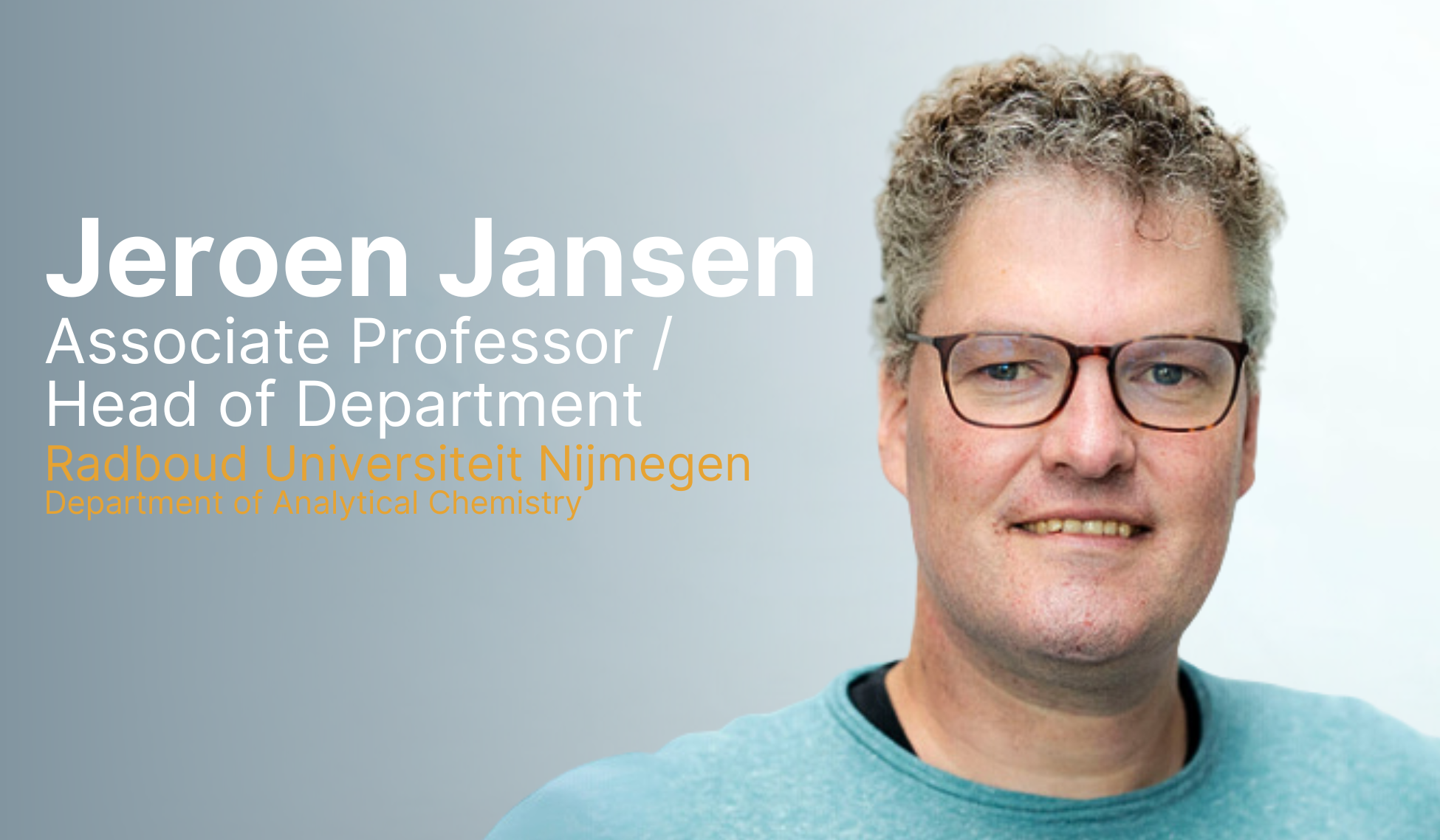
Chemometric models for sustainability
Contributing to sustainability with his research is one of the most important missions of Dr. Jeroen Jansen of Radboud University Nijmegen. By combining analytical technology and artificial intelligence, he creates digital models that help get the circular economy going and allows users to make better decisions themselves. Running chemical production processes in a plant more efficiently and determining the quality of residual flows are a few examples.
“Translating data into useful information for scientists, regulatory bodies and industry, that is mainly what those digital models should be able to do,” says Jansen. “That you can perform a measurement that is relevant to the user himself and that strengthens freedom of choice.”
Doing something digital with data from the laboratory inspired Jansen since the beginning of his studies. The biochemistry specialization appealed to him, but the amount of laboratory work was less attractive. He opted for chemometrics, in which mathematical and statistical methods are used to analyze (bio)chemical data. “The great thing with chemometrics is that you can make connections between all your laboratory data that took a lot of hard work to collect.”
AI and biology together
During his PhD research, he delved into the world of metabolites and combined metabolic data with chemometrics and Artificial Intelligence (AI). He developed a method for multivariable analysis of metabolomics data that is now widely used (ANOVA-Simultaneous Component Analysis (ASCA)). The method is very suitable for metabolomics studies where you have multiple experimental conditions and, for example, want to know which factors have the greatest influence on the metabolome and which metabolites specifically contribute to those effects. “It is essential to set up the research in the right way using design-of-experiments (DOE) from biology. Data from biology are more complex, more variable and focused on research. When you get very complicated mass spectra data that you cannot make sense of visually, you can still make statements using the predictive power of chemometrics and DOE from biology. In this way I have brought those two worlds together.”
AI for production processes in chemical plants
With all the developed models and knowledge from previous research, Jansen is now working with companies. He wants to contribute with AI to the sustainability of the chemical production processes in factories. For example, he and his group developed a ‘Machine-learned digital phase switch for sustainable chemical production’. “By means of measurements in a production process and a model developed for this purpose, one can predict when there is a tipping point during the running of processes in the factory. In other words, when people in the factory need to intervene. This prediction allows you to reduce useless moments, raw material and unnecessary energy consumption and shorten the production time.” “The great thing is that you can experiment much more digitally. Data for which you would normally have to do a lot of experiments in the laboratory can now be extracted from the normal process flow. With enough data, you can extrapolate which parameters are responsible for quality, production speed and costs.”
Decision moments in the process
“The predictions by the AI model must really help in making important decisions,” Jansen emphasises. This prediction must also reach someone who is allowed and able to do something with it. Certainly if the model indicates, for example, that something can go wrong in the factory within 5 minutes if no action is taken. “Although there is a lot of artificial in the AI-models, the knowledge of people in the process – from operator to designer to director – remains indispensable. Their insights help to improve the model and to ensure that the proposed actions are also really effective.”
Optimization of animal feed
Another completed project that Jansen is proud of is the optimization of animal feed recipes. “In this, we were able to clearly observe and improve quality, costs and environmental impact at the same time. Using online spectroscopy, you can perform quality analyses of ingredient flows in the animal feed industry. Since you know the quality but also the origin of the ingredients through fingerprinting, you can optimize the recipe of the compound feed in terms of quality, costs and environmental impact.”
Quality in recycling and circular economy
Jansen also helps to improve measuring the quality of residual flows (such as organic waste, plastics, etc.) with AI models. Since the composition of residual flows can vary greatly, determining their quality is both difficult and very important. Moreover, buyers and sellers each have different ideas about quality. “That is why we are proud that we are developing AI that can deal with this variable quality.” With in situ measurements with handheld spectroscopy, buyers and sellers can take measurements themselves that are relevant to their situation. The right AI then helps to convert these measurements into valuable information. “What makes our work special is that we not only generate data, but also translate it into decisions. The AI must therefore take the context into account: what does a measurement value mean for different users? In this way, we build smart, accessible tools that help people make better choices,” Jansen concludes.
Lab Technology 2025
 Registration website for Lab Technology 2025
Registration website for Lab Technology 2025Lab Technology 2025marketing@aleapublishers.nl
Lab Technology 2025marketing@aleapublishers.nlhttps://www.labtechnology.nl/157843
2025-06-03
2025-06-03
OfflineEventAttendanceMode
EventScheduled
Lab Technology 2025Lab Technology 20250.00EUROnlineOnly2019-01-01T00:00:00Z
To be announcedTo be announcedevent registration made easy
aanmelder.nl is the software partner for events.
Click here to discover the software.